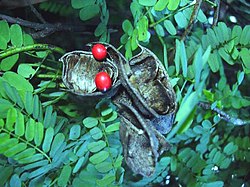Abrus precatorius: Difference between revisions
| Line 33: | Line 33: | ||
==Names== |
==Names== |
||
Abrus precatorius has different names in various Indian languages.<ref>Dr. K. M. Nadkarni's Indian Materia Medica, Volume 1, Edited by A. K. Nadkarni, Popular Prakashan, Bombay, 1976, pp. 5.</ref> |
Abrus precatorius has different names in various Indian languages.<ref>Dr. K. M. Nadkarni's Indian Materia Medica, Volume 1, Edited by A. K. Nadkarni, Popular Prakashan, Bombay, 1976, pp. 5.</ref> |
||
*[[Sanskrit language|Sanskrit]] : Gunja |
*[[Sanskrit language|Sanskrit]] : Gunja (गुंजा) |
||
*[[Hindi language|Hindi]] : Rati; Gaungchi; Gunchi; Gunja |
*[[Hindi language|Hindi]] : Rati; Gaungchi; Gunchi; Gunja (गुंजा) |
||
*[[Bengali language|Bengali]] : Kunch; Koonch |
*[[Bengali language|Bengali]] : Kunch; Koonch |
||
*[[Gujarati language|Gujarati]] : Gumchi; Chanothi |
*[[Gujarati language|Gujarati]] : Gumchi; Chanothi |
||
Revision as of 09:49, 14 November 2010
| Jequirity | |
|---|---|

| |
| Scientific classification | |
| Kingdom: | |
| Division: | |
| Class: | |
| Order: | |
| Family: | |
| Subfamily: | |
| Tribe: | |
| Genus: | |
| Species: | A. precatorius
|
| Binomial name | |
| Abrus precatorius | |
Abrus precatorius, known commonly as Jequirity, Crab's Eye, Rosary Pea, 'John Crow' Bead, Precatory bean, Indian Licorice, Akar Saga, Giddee Giddee or Jumbie Bead in Trinidad & Tobago,[1] is a slender, perennial climber that twines around trees, shrubs, and hedges. It is a legume with long, pinnate-leafleted leaves. It is also known as Gunja in Sanskrit and some Indian languages and Ratti in Hindi. With ratti name, it was also long used to measure 0.12125 grams of a traditional unit, mostly used by jewellers and Ayurved doctors.[2] The seeds are also often used as beads and in percussion instruments. The seed contains the poison abrin. The plant is native to Indonesia and grows in tropical and subtropical areas of the world where it has been introduced. It has a tendency to become weedy and invasive where it has been introduced.
Toxin
The toxin present in Abrus precatorius is called abrin. It is a dimer consisting of two protein subunits, termed A and B. The B chain facilitates abrin's entry into a cell by bonding to certain transport proteins on cell membranes, which then transport the toxin into the cell. Once inside the cell, the A chain prevents protein synthesis by inactivating the 26S subunit of the ribosome. One molecule of abrin will inactivate up to 1,500 ribosomes per second. Symptoms are identical to those of ricin, except abrin is more toxic by almost two orders of magnitude; the fatal dose of abrin is approximately 75 times smaller than the fatal dose of ricin. Abrin can kill with a circulating amount of less than 3 μg (micrograms). 'Abrus precatorius' is called "kudri mani" in Tamil and 'Guru Ginja' in Telugu. It is used in Siddha medicine for centuries. The Tamil Siddhars knew about the toxic effects in plants and suggested various methods which is called "suththi seythal" or purification. This is done by boiling the seeds in milk and then drying them. The protein is denatured when subjected to high temperatures which removes it toxicity.[citation needed][dubious – discuss]
Uses

The seeds of Abrus precatorius are much valued in native jewelry for their bright coloration. The third of the bean with the hilum (attachment scar) is black, and the rest is bright red, suggesting a ladybug. Jewelry-making with jequirity seeds is dangerous, and there have been cases of death by a finger-prick while boring the seeds for beadwork. However, it has long been a symbol of love in China, and its name in Chinese is xiang si dou (Chinese: 相思豆), or "mutual love bean".
In Trinidad in the West Indies the brightly coloured seeds are strung into bracelets and worn around the wrist or ankle to ward off jumbies or evil spirits and "mal-yeux" - the evil eye. A tea is made from the leaves and used to treat fevers, coughs and colds.[3]
The Tamils use Abrus precatorius seeds of different colors. The red variety with black eye is the most common, but there are black, white and green varieties as well. In Siddha medicine the white variety is used to prepare oil that is used as an aphrodisiac.[4]
Names
Abrus precatorius has different names in various Indian languages.[5]
- Sanskrit : Gunja (गुंजा)
- Hindi : Rati; Gaungchi; Gunchi; Gunja (गुंजा)
- Bengali : Kunch; Koonch
- Gujarati : Gumchi; Chanothi
- Kannada : Gurugunji
- Kashmiri : Shangir
- Malayalam : Kunni; Gundumani
- Persian : Gunchi; Chashami-Khurosa
- Punjabi : Mulati
- Tamil : Gundumani; Kunthamani
- Telugu : Guruginia (గురివింద)
Gallery
-
Abrus precatorius from Koehler's Medicinal-Plants
-
Bright red seeds of A. precatorius are strung as jewelry
-
Abrus precatorius leaves & flowers
-
Abrus precatorius flowers
Footnotes
- ^ Mendes (1986), p. 79.
- ^ Abrus precatorius : Gunja (Ratti)|Bhopal Birds|Parag Bakshi, March 01, 2007|Archieved on March 17, 2010
- ^ Mendes (1986), p. 79.
- ^ Dr.J.Raamachandran, "HERBS OF SIDDHA MEDICINES-The First 3D Book on Herbs", page 2
- ^ Dr. K. M. Nadkarni's Indian Materia Medica, Volume 1, Edited by A. K. Nadkarni, Popular Prakashan, Bombay, 1976, pp. 5.
References
- Mendes, John (1986). Cote ce Cote la: Trinidad & Tobago Dictionary. Arima, Trinidad.
- List of plants of Caatinga vegetation of Brazil
- Abrus precatorius seed (extremeclose-up)




